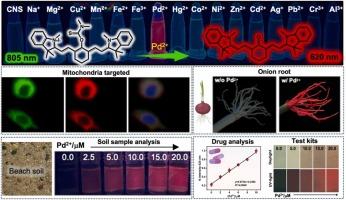构建生态友好、生物兼容、比例计量的近红外荧光传感器,用于快速检测真实样品和活细胞中的痕量Pd2+
IF 11.3
1区 环境科学与生态学
Q1 ENGINEERING, ENVIRONMENTAL
引用次数: 0
摘要
钯的工业使用日益增加,导致其在环境中积累,引起人们对其对水生生物和人类健康的毒性的关注。因此,能够检测Pd2+的荧光探针是非常有益的。为此,以菁染料2 ((E)-2-((E)-2-((二甲基氨基甲氧基))-3-(2-((Z)-1,3,3-三甲基林-2基)乙基)环己烯-1-烯-1-基)乙烯基)-1,3,3-三甲基- 3h -吲哚-1-碘化ium (CNS)为基础,合成了一种新的近红外荧光探针,用于选择性和快速检测Pd2+。检测反应遵循消除硫氨基甲酸酯部分,导致高荧光产物。CNS具有显著的灵敏度(检测限:0.105 μM),高选择性,短响应时间(1.0 min),长寿命(0.88 ns),并且易于检测Pd2+暴露后的颜色变化。集成了智能手机检测系统的cns负载薄层色谱条能够检测溶液、土壤和药物样品中的Pd2+。此外,CNS使洋葱根和表皮中Pd2+的浓度依赖性检测成为可能。由于CNS具有低细胞毒性、膜通透性好、近红外荧光和高对比度等优点,已成功应用于活细胞的Pd2+生物成像,靶向线粒体。与现有探针相比,CNS为传感应用提供了优越的灵敏度、选择性和适应性。本文章由计算机程序翻译,如有差异,请以英文原文为准。

Building an eco-friendly, biocompatible, and ratiometric NIR fluorescent sensor for the rapid detection of trace Pd2+ in real samples and living cells
The increasing industrial use of palladium has led to its environmental accumulation, raising concerns about its toxicity to aquatic life and human health. Therefore, fluorescent probes capable of detecting Pd2+ are highly beneficial. With this objective, a new near-infrared (NIR) fluorescent probe based on a cyanine dye, 2 ((E)-2-((E)-2-((dimethylcarbamothioyl)oxy)-3-(2-((Z)-1,3,3-trimethylindolin-2ylidene)ethylidene)cyclohex −1-en-1-yl)vinyl)-1,3,3-trimethyl-3H-indol-1-ium iodide (CNS), was synthesized for selective and rapid detection of Pd2+. The detection reaction followed the elimination of thiocarbamate moiety, leading to the highly fluorescent product. CNS demonstrated remarkable sensitivity (detection limit: 0.105 μM), high selectivity, short response time (1.0 min), long lifetime (0.88 ns), and easily detectable color changes upon Pd2+ exposure. A CNS-loaded TLC strip integrated with a smartphone detection system was able to detect Pd2+ in solutions, soil, and drug samples. In addition, CNS enabled concentration-dependent detection of Pd2+ in onion roots and epidermis. Because of low cytotoxicity, good membrane permeability, NIR fluorescence, and high contrast, CNS has been successfully applied to Pd2+ bioimaging in living cells, targeting mitochondria. Compared to existing probes, CNS offers superior sensitivity, selectivity, and adaptability for sensing applications.
求助全文
通过发布文献求助,成功后即可免费获取论文全文。
去求助
来源期刊

Journal of Hazardous Materials
工程技术-工程:环境
CiteScore
25.40
自引率
5.90%
发文量
3059
审稿时长
58 days
期刊介绍:
The Journal of Hazardous Materials serves as a global platform for promoting cutting-edge research in the field of Environmental Science and Engineering. Our publication features a wide range of articles, including full-length research papers, review articles, and perspectives, with the aim of enhancing our understanding of the dangers and risks associated with various materials concerning public health and the environment. It is important to note that the term "environmental contaminants" refers specifically to substances that pose hazardous effects through contamination, while excluding those that do not have such impacts on the environment or human health. Moreover, we emphasize the distinction between wastes and hazardous materials in order to provide further clarity on the scope of the journal. We have a keen interest in exploring specific compounds and microbial agents that have adverse effects on the environment.
 求助内容:
求助内容: 应助结果提醒方式:
应助结果提醒方式:


